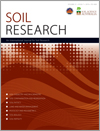SR18347Effects of tillage intensity on pore system and physical quality of silt-textured soils detected by multiple methods
 , Janis Kreiselmeier
, Janis Kreiselmeier  , Parvathy Chandrasekhar
, Parvathy Chandrasekhar  , Stefan Julich
, Stefan Julich  , Karl-Heinz Feger
, Karl-Heinz Feger  , Kai Schwärzel
, Kai Schwärzel  , Gernot Bodner
, Gernot Bodner  and Andreas Schwen
and Andreas Schwen
Soil management interventions such as tillage affect the pore system and physical quality of soils, but forecasting such changes lacks a sound scientific basis. We used high-resolution measurement methods on silt-dominated soils under four soil management systems with decreasing mechanical intensity and found compaction and aeration deficits in all soils, most distinctively under no tillage. Despite the well-known advantages of no-till systems, this emphasises the need for a comprehensive site-based analysis of soil physical risks and opportunities when designing soil management regimes.
SR18347 Abstract | SR18347 Full Text | SR18347PDF (553 KB) Open Access Article




